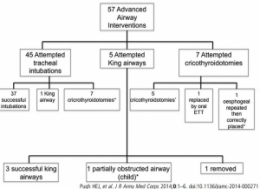Airway: Pratiques UK en Helmand
12/08/2015
A review of pre-admission advanced airway management in combat casualties, Helmand Province 2013
Pugh HE et Al. J R Army Med Corps. 2015 Jun;161(2):121-6.
--------------------------------------------
Il faut savoir intuber et ouvrir un cou. Ce qui fait la médicalisation de l'avant n'est pas la présence d'un docteur en médecine mais d'un professionnel de santé ayant la pratique de gestes de réanimation préhospitalière et capable de les mettre en oeuvre de faon opportune. La gestion des voies aériennes en est l'exemple.
--------------------------------------------
OBJECTIVES:
Airway compromise is the third leading cause of potentially preventable combat death. Pre-hospital airway management has lower success rates than in hospital. This study reviewed advanced airway management focusing on cricothyroidotomies and supraglottic airway devices in combat casualties prior to admission to a Role 3 Hospital in Afghanistan.
METHODS:
This was a retrospective review of all casualties who required advanced airway management prior to arrival at the Role 3 Hospital, Bastion, Helmand Province over a 30-week period identified by the US Joint Theatre Trauma Registry. The notes and relevant X-rays were analysed. The opinions of US and UK clinical Subject Matter Experts (SME) were then sought.
RESULTS:
Fifty-seven advanced airway interventions were identified. 45 casualties had attempted intubations, 37 (82%) were successful and of those who had failed intubations, one had a King LT Airway (supraglottic device) and seven had a rescue cricothyroidotomy. The other initial advanced airway interventions were five attempted King LT airways and seven attempted cricothyroidotomies. In total, 14 cricothyroidotomies were performed; in this group, there were nine complications/significant events.
CONCLUSIONS:
The SMEs suggested that dedicated surgical airway kits should be used and students in training should be taught to secure the cricothyroidotomy tube as well as how to insert it. This review re-emphasises the need to 'ensure the right person, with the right equipment and the right training, is present at the right time if we are to improve the survival of patients with airway compromise on the battlefield'. The audit reference number is RCDM/Res/Audit/1036/12/0368.



Les commentaires sont fermés.